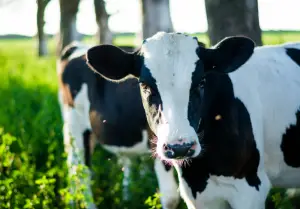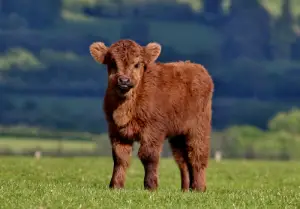How Much Does It Cost To Buy A Cow?
Almost every homesteader dreams about having a cow grazing in the field. This is understandable, as cattle offer a considerable amount of meat, milk, and sustainability compared to the maintenance and cost required. If you are considering adding a cow to your herd, you’ll need to first determine whether you have the financial means to support her.
How much does it cost to buy a cow? You can buy a cow for around $1,000, but the animal herself will only account for a portion of the expense. Additional up-front costs associated with raising a cow may come out to several thousand dollars, with fencing being the largest expense. Ongoing costs will revolve mainly around hay and can reach up to $2,500 annually for a single cow without adequate pasture.
If you’re interested in getting a detailed breakdown of the costs of buying and owning a cow, read on.
Initial Costs Of Buying And Keeping A Cow
The upfront costs to keeping a cow are not unlike those required for keeping other livestock. Besides the cost of the animal itself, your biggest expenses will likely be fencing and adequate shelter.
Buying A Cow Cost
How much you should expect to pay for a cow will depend on what you are looking for. If your intent is to raise your own beef, you will likely be looking for a young steer (male who has been castrated). You can usually find a young steer or bull calf of a beef-breed for around $1,000.
If you are looking for a dairy cow, you can usually buy a dairy-breed heifer for around $500 or an experienced dairy-breed cow for around $1,500. Generally, the younger the animal, the lower the cost – so if you are hoping to save money upfront, you may opt to buy a young calf or “bottle baby”.
Costs of Providing Shelter For Your Cow 
Cattle are hardy animals and need little in the way of shelter. If you have adequate fencing and little predator concern, there is usually no reason to keep a healthy cow in a barn at night, except for birthing. While a cow should have a covered area to escape the elements while grazing, the right shelter will depend on the weather in your area.
If you live in a warm or temperate climate, you may need nothing more than a couple of shade trees for your cow. If you live in a climate with harsh Winters, a simple 3-sided cow shelter should be the most that you will need, which you can expect to build for as little as $500.
Cost of Fencing For Your Cow
Fencing is likely to be the biggest investment when raising a cow or steer because cattle need a larger amount of space when compared to other livestock. The more area you need to fence, the higher the fencing cost will be.
Fortunately, cattle are not known to test boundaries in the way that some other animals are, and simple T-posts with high-tensile or woven wire fencing are often perfectly adequate in preventing a cow from intentionally escaping.
Of course, given a cow’s size, she is likely to accidentally escape if she damages a fence by using it to scratch an itch. For this reason, you will want to encourage the cow to stay away from the fence entirely, to protect its integrity.
How do you protect the fence from a 1,000-pound animal? While you can use a strand of electrical fencing, it is usually just as effective (and much less expensive) to instead use a strand of barbed wire about 24 inches from the top of the fence. Some argue that barbed wire can injure a curious cow, but it is an effective deterrent that has been used for many years.
Keeping your cow in, however, is only half of the concern when it comes to fencing. If you have large predators in your area, you will likely need to use a hot wire to keep them out. While mature, healthy cattle are not as likely to fall prey to smaller predators like coyotes, a pack of wolves or a grizzly bear can cause significant damage to your large livestock.
Understanding all of the variables associated with fencing, the cost will be reflective of your situation and your needs. While it is impossible to give a generalized estimate here, most homesteaders should anticipate spending at least $2,000 on fencing.
Costs of Additional Cow Supplies
Cattle, like all animals, require access to fresh and clean water at all times. A dairy cow, when in milk, can drink up to 30-50 gallons of water per day. You can purchase simple rubber or galvanized steel water trough for around $250 in most farm supply stores.
Unless your cow has access to adequate pasture year-round, she will also need supplemental hay. Ground feeding, for most livestock, is no longer advised due to both issues of waste and introduction of ground parasites.
It is therefore recommended that you include a hay feeder in your pasture. This can be as simple as a homemade feeder built from used pallets, or a cattle-specific feeder available at most feed stores for around $400.
Many homesteaders make a practice of halter-training their cattle as a convenience for various husbandry tasks. If you decide to halter-train your cow, you can purchase a halter and lead for around $25 online. This is a practice more easily taught to calves but can be introduced to older cattle as well (especially when using treats).
Total Initial Cost Of A Cow
While there are a number of variables associated with the total up-front cost of purchasing and preparing for a cow, you should expect to spend at least $4,000 up-front. This cost will change greatly depending on your fencing needs, and if you already have a fully-fenced pasture this number can be significantly reduced.
Maintenance Costs Of Buying And Raising A Cow
In addition to the startup costs, there are several ongoing costs of raising cattle – including feed, vet bills, and vaccinations.
Costs of Feeding Your Cow 
A cow with unlimited access to healthy, year-round pasture will usually require no supplementation. You will need a lot of land to feed one cow in this manner though. A standard rule of thumb is that 1 acre of pasture will feed 1 cow for 50 days (before needing to be rotated).
This means that you will need to have at least 3-4 acres of year-round pasture to feed one cow, depending on how quickly your pasture recovers. The average homesteader will be unable to offer this lifestyle and will therefore need to supplement with hay.
Cattle are big eaters, and a mature cow can eat as much as 25 pounds of hay per day. This means that good-quality hay will likely be the biggest expense for someone keeping a steer or dairy cow. The cost of hay can vary greatly between locations, but you might expect to pay around $15 for a 50-pound bale of hay in most areas. If your cow is eating ½ a bale of hay per day, this would equal around $225 per month to feed one cow.
Cow Vet Costs, Deworming, and Vaccinations
If your cow should need to see a vet, you should expect to pay a minimum of $100 for an onsite vet call. The cost will only go up from there, depending on the issue that has arisen. Fortunately, cattle are typically healthy animals and you should not expect to have to call a vet out very often.
Vaccination and deworming protocols will vary by region, and it is best to discuss this plan with your vet. On average, most mature cattle herds are vaccinated twice yearly, and de-wormed annually. You can administer a de-wormer such as Ivermectin yourself, at the cost of around $50 per liter.
There are a number of vaccines recommended for a healthy, mature cattle herd, and you will want to discuss with your vet or an experienced rancher near you to determine which are recommended for your area. Some vaccines may be available to you over the counter, while some must be administered by a vet.
Total Yearly Cow Costs of Buying And Owning A Cow 
In terms of feeding, you should anticipate paying around $2,500 per year to feed a cow on hay alone. If you have seasonal pasture, this number will come down. In addition to feed, you will want to set aside an additional few hundred dollars for vaccinations and de-worming.
Can A Cow Live Alone?
Cows are herd animals, as are most livestock, and are happiest living with others of their kind. That said, raising multiple 1,000-pound animals is a bit more complicated than raising multiple chickens or goats. While an animal’s physical and emotional welfare should be at the forefront of any homesteader’s mind, so should practicality.
If you only have the space or the ability to raise a single cow, you don’t need to let that stop you. Instead, consider fulfilling some of her social needs by adding a couple of goats, sheep, or even a llama to the pasture with her. This will give her company and keep her from getting too lonely.
You can read more of my recent articles about cows in the articles below!

